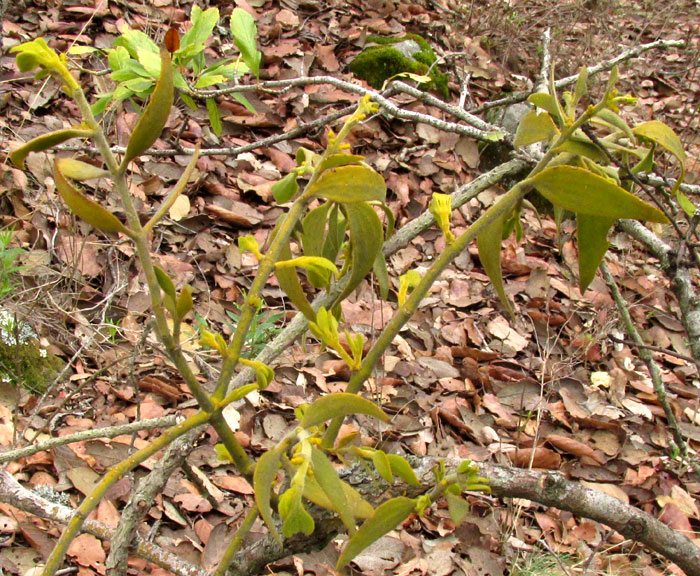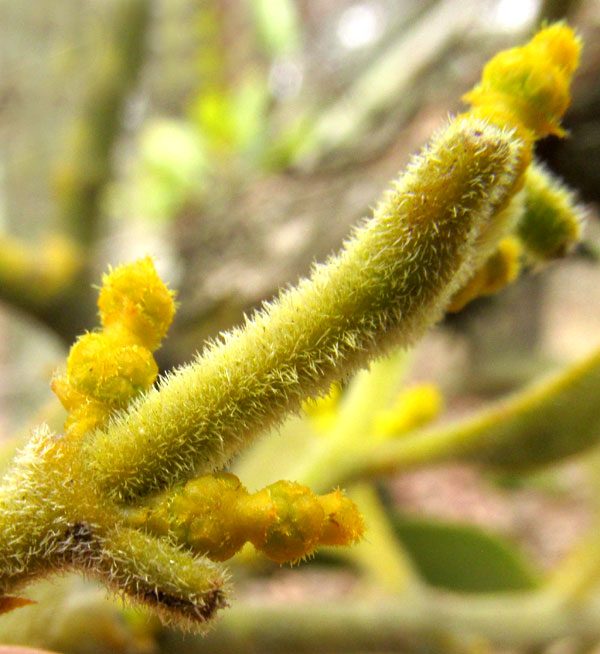Excerpts from Jim Conrad's
Naturalist Newsletter
entry from field notes dated July 3, 2022, taken on the eastern lower slope of Cerro de la Cruz, at an elevation of ~2700m (~8850 ft), just south of the community of El Pinar, Amealco de Bonfil, Querétaro, MÉXICO, (~N20.17°, ~W100.17°)
PHORADENDRON VELUTINUM

In the oak forest mantling the steep, lower eastern slope of Cerro de la Cruz, the orangish yellow mistletoe pictured above arose from the stem of a Mexican Hawthorn, Crataegus mexicana. Growing where most of the day the oaks shaded the ground, the small hawthorn, whose leaves and stems are visible in the background of the above picture, was spindly and weak compared to others in nearby fields. That may explain why mistletoe grew on this tree and not the others. The mistletoe, though, was doing well, at the end of a very dry, prolonged dry season, issuing new flowers, shown below:

In the above picture, the flowers are immature. Several unisexual flowers are tightly packed in two or three roundish clusters gathered on spikelike inflorescences. The flowers when fully developed will consist of three tiny, triangular petals but no sepals. Each plant will bear only male or only female flowers, so this mistletoe species is dioecious.
Species known as mistletoes are dispersed in numerous genera and at least a couple of plant families, occurring nearly worldwide. In the Americas, if your mistletoe bears flat-bladed leaves and clusters of tiny flowers in spikelike inflorescences such as shown in our pictures, it belongs to the genus Phoradendron, with maybe 244 species or so occurring only in the Americas. In our upland region of central Mexico known as the Bajío, about 20 Phoradendron species have been documented.
In our region, if you have a Phoradendron that's woolly hairy like the above picture shows, the leaves are finger-thick or so, and the leaf tips sharply pointed as seen in the above photo, and especially if your plant is parasitizing a hawthorn, you have PHORADENDRON VELUTINUM.
Phoradendron velutinum, which has no English name, occurs in uplands from northern Mexico south to Honduras, at elevations of about 2000-2850m (6500-9400 feet). It parasitizes other species than hawthorns, such as kinds of Mimosa, cherry and oak trees, but hawthorns are its favorite. It's fortunate that our plant grew on a hawthorn, because there's another species in this area, Phoradendron brachystachyum, which is fairly similar, and so variable in appearance that it can look very similar to our hawthorn one, but it's not particularly fond of hawthorns, nor quite so hairy.
When speaking of a Phoradendron mistletoe as parasitizing a tree, it's to be understood that the mistletoe is only "hemiparasitic" -- half-way parasitic. Our plant does possess photosynthesizing leaves, albeit our species' leaves don't appear to possess as much green chlorophyll as many other mistletoe species.
In a sense, hemiparasites benefit from two incomes, their food being both photosynthesized by themselves with the help of sunlight, as well as coming from their victim's stolen, nutrient-rich sap. Interestingly, it's been observed, as by Helen Quested and others in a 2003 paper entitled "Litter of the hemiparasite Bartsia alpina enhances plant growth: evidence for a functional role in nutrient cycling," that "Hemiparasitic angiosperms concentrate nutrients in their leaves and also produce high quality litter, which can decompose faster and release more nutrients than that of surrounding species." Therefore, our Phoradendron may be enriching the soil its hawthorn grows in, helping the hawthorn and others in the community.
Certainly birds benefit from eating the plant's berry-type fruits. And then the birds in return help the mistletoes when they clean off their beaks being wiped on tree branches. The mistletoes' small seeds are included in the sticky fruit pulp collected on the bird's beak. The seeds lodge in cracks of the tree's bark, where they germinate.
Nowadays the trend seems to be to assign Phoradendron mistletoes to the Sandalwood Family, the Santalaceae, though most of the floras in circulation, including the Flora of North America, still assign them to what's been called the Mistletoe Family, the Visaceae. I first learned that they belonged to the Loranthaceae, which also was called the Mistletoe Family. Whatever the family, the genus Phoradendron seems to be a solid one, probably the largest Mistletoe genus, mainly tropical and warm temperate, with its center of diversity in the Amazon rainforest.